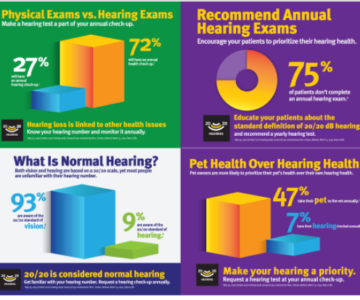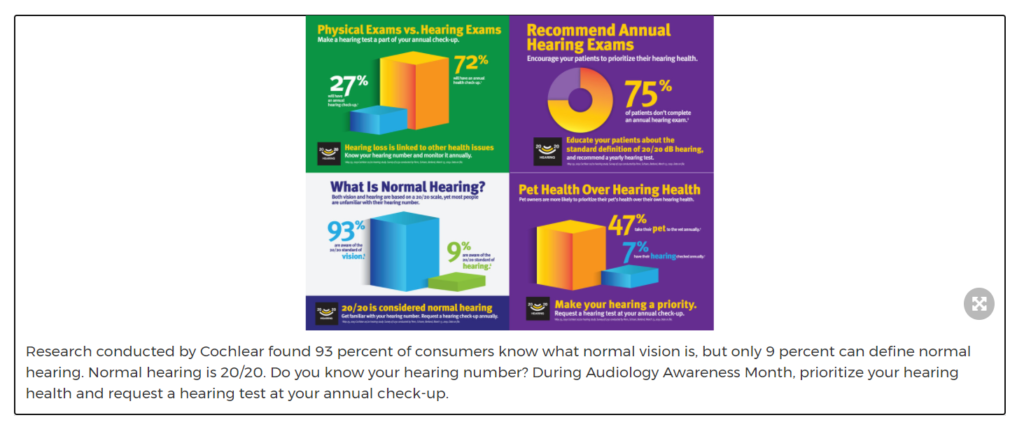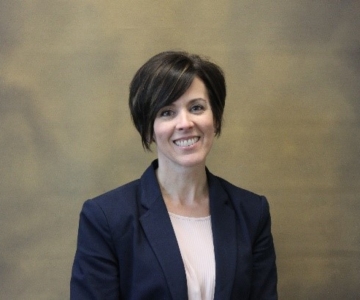Most adults with only one normal hearing ear report challenges in some environments. These reports vary from occasional difficulty listening in noise to significant struggles that impact relationships and employment. For many years, medical professionals believed that unilateral hearing loss (UHL)/single sided deafness (SSD) was a condition that did not require any intervention. Recent clinical studies demonstrate that treating single sided deafness with a hearing implant can improve speech understanding in noise1-17. Importantly, these studies also showed reduced listening effort and fatigue, especially in noisy environments,8,13 and a majority reported an improvement in their tinnitus following cochlear implantation.3,7,9,18
Christine Menapace, Vice President of Clinical, Quality and Regulatory at Cochlear, identified a need for best practice guidelines through discussion with leading experts about the growing body of evidence. As a result, Dr. Kevin Brown and Christine brought together 24 experts to develop clinical recommendations.19

The Cochlear™ Nucleus® 8 Sound Processor is now available! Featuring our smartest technology yet, SmartSound® iQ 2 with SCAN 2,* the Nucleus 8 more accurately senses changes in the listening environment and automatically adjusts settings to deliver clearer sound.21-24
Treatment options
The SSD Thought Leadership Group reviewed existing literature to identify key focus areas in the clinical evaluation and treatment process. Four primary treatment pathway options were identified, including no treatment (observation), Contralateral Routing of Signals (CROS) or Bi-CROS hearing aids, bone conduction solutions and cochlear implants. While it is important to note that a CROS hearing aid system may be a successful solution for some patients with UHL/SSD, cochlear implants offer significant improvement in speech understanding in noise and sound localization.3,20

The hard work of this group resulted in the guidance document, “Clinical Recommendations for the Treatment of Unilateral Hearing Loss/Single Sided Deafness with Cochlear Implantation,” which is a robust resource for medical professionals seeking current best practices for treating single sided deafness.19
The modern world is a noisy place, and a significant portion of our communication – whether work related or social – happens in complex listening environments. Thanks to advances in bone conduction implant technology and expanded indications for cochlear implants, new options with better outcomes are available for treating single sided deafness.
Read “Clinical Recommendations for the Treatment of Unilateral Hearing Loss/Single Sided Deafness with Cochlear Implantation” for ideas on best practice!
Lin LM, Bowditch S, Anderson MJ, May B, Cox KM, Niparko K. “Amplification in the rehabilitation of unilateral deafness: speech in noise and directional hearing effects with bone-anchored hearing and contralateral routing of signal amplification.” Otology & Neurotology. 2006;27(2):172–82.
Hol MK, Snik AF, Mylanus EA, Cremers CW. Long-term results of bone anchored hearing aid recipients who had previously used air-conduction hearing aids. Arch Otolaryngol Head Neck Surg 2005 Apr;131(4):321–5.
Arndt, S., Laszig, R., Aschendorff, A., Hassepass, F., Beck, R., & Wesarg, T. (2017). Cochlear implant treatment of patients with single-sided deafness or asymmetric hearing loss. Hno, 65(February), 98–108. https://doi.org/10.1007/s00106-016-0297-5
Bernstein, J. G. W., Schuchman, G. I., & Rivera, A. L. (2017a). Head shadow and binaural squelch for unilaterally deaf cochlear implantees. Otology and Neurotology, 38(7), e195–e202. https://doi.org/10.1097/MAO.0000000000001469
Dirks, C., Nelson, P. B., Sladen, D. P., & Oxenham, A. J. (2019). Mechanisms of Localization and Speech Perception with Colocated and Spatially Separated Noise and Speech Maskers Under Single-Sided Deafness with a Cochlear Implant. Ear and Hearing, 40(6), 1293–1306. https://doi.org/10.1097/AUD.0000000000000708
Dorbeau, C., Galvin, J., Fu, Q. J., Legris, E., Marx, M., & Bakhos, D. (2018). Binaural Perception in Single-Sided Deaf Cochlear Implant Users with Unrestricted or Restricted Acoustic Hearing in the Non-Implanted Ear. Audiology and Neurotology, 23(3), 187–197. https://doi.org/10.1159/000490879
Friedmann, D. R., Ahmed, O. H., McMenomey, S. O., Shapiro, W. H., Waltzman, S. B., & Thomas Roland Jr, J. (2016). Single-sided Deafness Cochlear Implantation: Candidacy, Evaluation, and Outcomes in Children and Adults. In Otol Neurotol (Vol. 37).
Härkönen K, Kivekäs I, Rautiainen M, Kotti V, Sivonen V, V. J. (2015). Single-Sided Deafness: The Effect of Cochlear Implantation on Quality of Life, Quality of Hearing, and Working Performance. ORL J Otorhinolaryngol Relat Spec, 77(6), 339–345.
Häußler, S. M., Knopke, S., Dudka, S., Gräbel, S., Ketterer, M. C., Battmer, R. D., Ernst, A., & Olze, H. (2019). Improvement in tinnitus distress, health-related quality of life and psychological comorbidities by cochlear implantation in single-sided deaf patients. German version. Hno, 67(11), 863–873. https://doi.org/10.1007/s00106-019-0706-7
Legris, Elsa, Galvin, J., Roux, S., Gomot, M., Aoustin, J. M., Marx, M., He, S., & Bakhos, D. (2018). Cortical reorganization after cochlear implantation for adults with single-sided deafness. PLoS ONE, 13(9), 1–22. https://doi.org/10.1371/journal.pone.0204402
Lorens, A., Kruszyńska, M., Obrycka, A., Skarzynski, P. H., Wilson, B., & Skarzynski, H. (2019). Binaural advantages in using a cochlear implant for adults with profound unilateral hearing loss. Acta Oto-Laryngologica, 139(2), 153–161. https://doi.org/10.1080/00016489.2018.1535190
Müller, V., & Lang-Roth, R. (2021). Speech recognition with informational and energetic maskers in patients with single-sided deafness after cochlear implantation. Journal of Speech, Language, and Hearing Research, 64(8), 3343–3356. https://doi.org/10.1044/2021_JSLHR-20-0067
Peter, N., Kleinjung, T., Probst, R., Hemsley, C., Veraguth, D., Huber, A., Caversaccio, M., Kompis, M., Mantokoudis, G., Senn, P., & Wimmer, W. (2019). Cochlear implants in single-sided deafness – clinical results of a Swiss multicentre study. Swiss Medical Weekly, 149, w20171.
Rahne, T., & Plontke, S. K. (2016). Functional result after cochlear implantation in children and adults with single-sided deafness. Otology and Neurotology, 37(9), e332–e340. https://doi.org/10.1097/MAO.0000000000000971
Speck, I., Ketterer, M. C., Arndt, S., Aschendorff, A., Jakob, T. F., & Hassepass, F. (2020). Comparison of Speech Recognition and Localization Ability in Single-sided Deaf Patients Implanted With Different Cochlear Implant Electrode Array Designs. https://doi.org/10.1097/MAO.0000000000002864
Thomas, JP., Neumann, K., Dazert, S., & Voelter, C. (2017). Cochlear implantation in children with congenital single-sided defness. Otology & Neurotology, 38. 496-503.
Williges, B., Wesarg, T., Jung, L., Geven, L. I., Radeloff, A., & Jürgens, T. (2019). Spatial Speech-in-Noise Performance in Bimodal and Single-Sided Deaf Cochlear Implant Users. Trends in Hearing, 23. https://doi.org/10.1177/2331216519858311
Van de Heyning P, Vermeire K, Diebl M, et al. Incapacitating unilateral tinnius in single-sided deafness treated by cochlear implanation. Ann Otol Rhinol Larngol 2008: 117: 645-652
Brown, K. et al (2022). Clinical recommendations for the treatment of unilateral hearing loss/single sided deafness with cochlear implantation [White paper].
Louza, J., Hempel, J. M., Krause, E., Berghaus, A., Müller, J., & Braun, T. (2017). Patient benefit from Cochlear implantation in single-sided deafness: a 1-year follow-up. European Archives of Oto-Rhino-Laryngology, 274(6), 2405–2409. https://doi.org/10.1007/s00405-017-4511-1
Mauger SJ, Warren C, Knight M, Goorevich M, Nel E. Clinical evaluation of the Nucleus 6 cochlear implant system: performance improvements with SmartSound iQ. International Journal Of Audiology. 2014, Aug; 53(8): 564-576. [Sponsored by Cochlear].
Mauger S, Jones M, Nel E, Del Dot J. Clinical outcomes with the Kanso™ off- the-ear cochlear implant sound processor. International Journal Of Audiology. 2017, Jan 9; 1-10. [Sponsored by Cochlear].
Wolfe J, Neumann S, Marsh M, Schafer E, Lianos L, Gilden J, O’Neill L, Arkis P, Menapace C, Nel E, Jones M. Benefits of Adaptive Signal Processing in a Commercially Available Cochlear Implant Sound Processor. Otol Neurotol. 2015 Aug;36(7):1181-90. [Sponsored by Cochlear]. [Sponsored by Cochlear].
Cochlear Limited D1864200 SCAN 2 Design Description
*It is recommended that SNR-NR, WNR and SCAN be made available to any recipient, ages 6 and older, who is able to 1) complete objective speech perception testing in quiet and noise in order to demonstrate and document performance and 2) report a preference for different program settings.
*The Cochlear Kanso 2 Sound Processor and the Cochlear Nucleus 8 are compatible with Apple and Android devices, for compatibility information visit www.cochlear.com/compatibility. For compatibility information visit www.cochlear.com/compatibility. The Cochlear Nucleus Smart App is available on App Store and Google Play. For compatibility information visit www.cochlear.com/compatibility.
This material is intended for health professionals. If you are a consumer, please seek advice from your health professional about treatments for hearing loss. Outcomes may vary, and your health professional will advise you about the factors which could aff ect your outcome. Always read the instructions for use. Not all products are available in all countries. Please contact your local Cochlear representative for product information. Views expressed are those of the individual. Consult your health professional to determine if you are a candidate for Cochlear technology.
©Cochlear Limited 2023. All rights reserved. ACE, Advance Off -Stylet, AOS, Ardium, AutoNRT, Autosensitivity, Baha, Baha SoftWear, BCDrive, Beam, Bring Back the Beat, Button, Carina, Cochlear, 科利耳, コクレア, 코클리어, Cochlear SoftWear, Contour, コントゥア, Contour Advance, Custom Sound, DermaLock, Freedom, Hear now. And always, Hugfi t, Human Design, Hybrid, Invisible Hearing, Kanso, LowPro, MET, MP3000, myCochlear, mySmartSound, NRT, Nucleus, Osia, Outcome Focused Fitting, Off -Stylet, Piezo Power, Profi le, Slimline, SmartSound, Softip, SoundArc, True Wireless, the elliptical logo, Vistafi x, Whisper, WindShield and Xidium are either trademarks or registered trademarks of the Cochlear group of companies.







